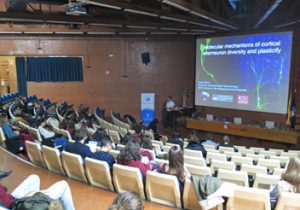Neuron development in the cerebral cortex
PhD workshop master lecture

Dr Oscar Marín, director of the MRC Centre for Developmental Neurobiology at King’s College London.
On Friday December 1, the master lecture “Molecular mechanisms of cortical interneuron diversity and plasticity” was given by the researcher Oscar Marín, director of the MRC Centre for Developmental Neurobiology in King’s College London. His research group analyses the mechanisms that control migration and position of brain cortex neurons during its development, mainly on mice models.
Dr Marín started his lecture with an introduction to the brain cortex and its main types of neurons. There are two main types of neurons: on the one hand, the pyramidal ones, which account for the 80 % of the cortex neurons approximately, and transmit information among the different cortical regions and to other brain areas. Then, there are the interneurons, a group of heterogeneous neurons that make inhibiting local connections. These two types of neurons come from different areas and progenitors: progenitors of the pyramidal type ones are found in the pallium and interneurons are created in the subpalium, the area in the cerebrum where other structures such as the basal ganglion and the tonsils are formed.

The master lecture in the PhD Workshop took place in the Aula Magna of the Ramon Margalef building at the Faculty of Biology of the UB.
There are two alternative models to explain the specification of interneurons during their development. The first model, the early specification, is focused on an intrinsic waterfall of transcription factors, and the second model is based on a combination of the intrinsic gene program mixed with a genetic program that depends on its context. The results of Dr Marín’s group support the first model. They work on this issue with different approaches. During this development, interneurons migrate to the cortex through defined routes. Although there is no correlation between the origin and the migration path yet, there are specific groups that make certain migrations. In some experiments, groups of interneurons have an early fixed destination, at least when they migrate to the cortex during the development, but the issue is how soon this takes place. In order to solve this, Dr Marín’s group used single cell sequencing and considered whether data can be taken from new born cells so they can be described.
At the end of the lecture, some PhD students shared their questions, which were mainly related to how their research can help understand the etiology of mental disorders better, especially the role some genes play in these disorders.



No Comments